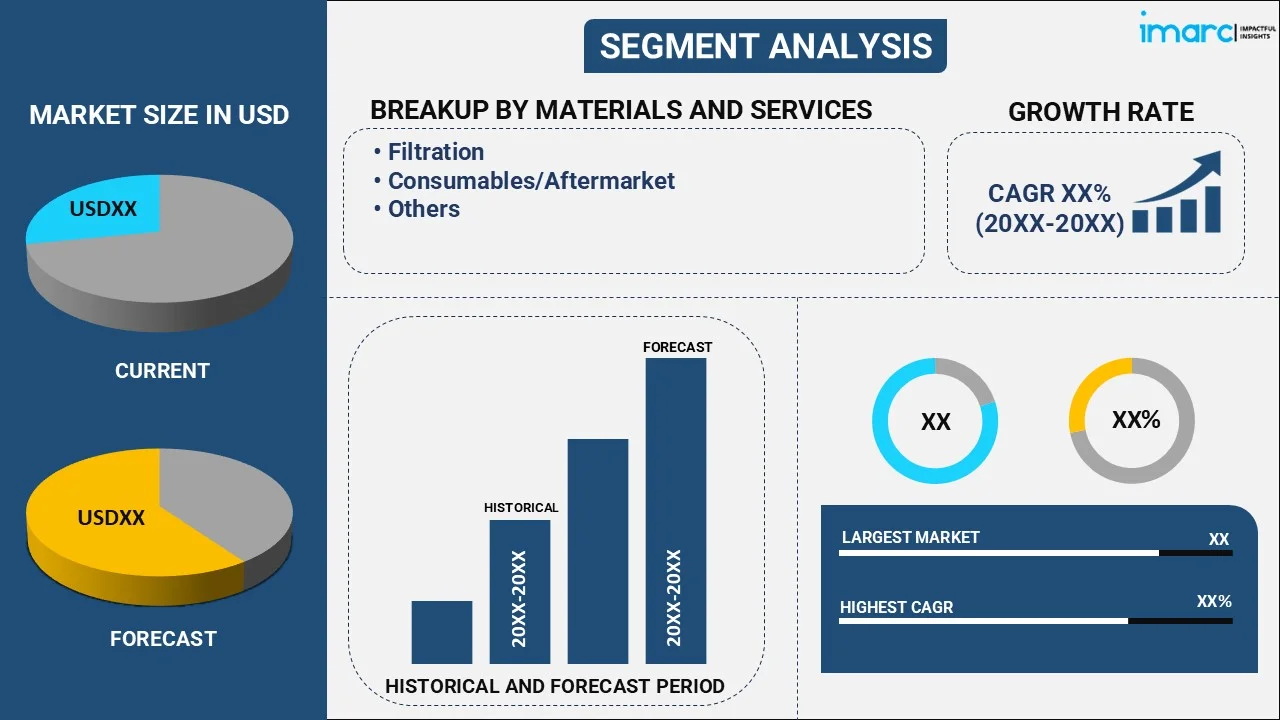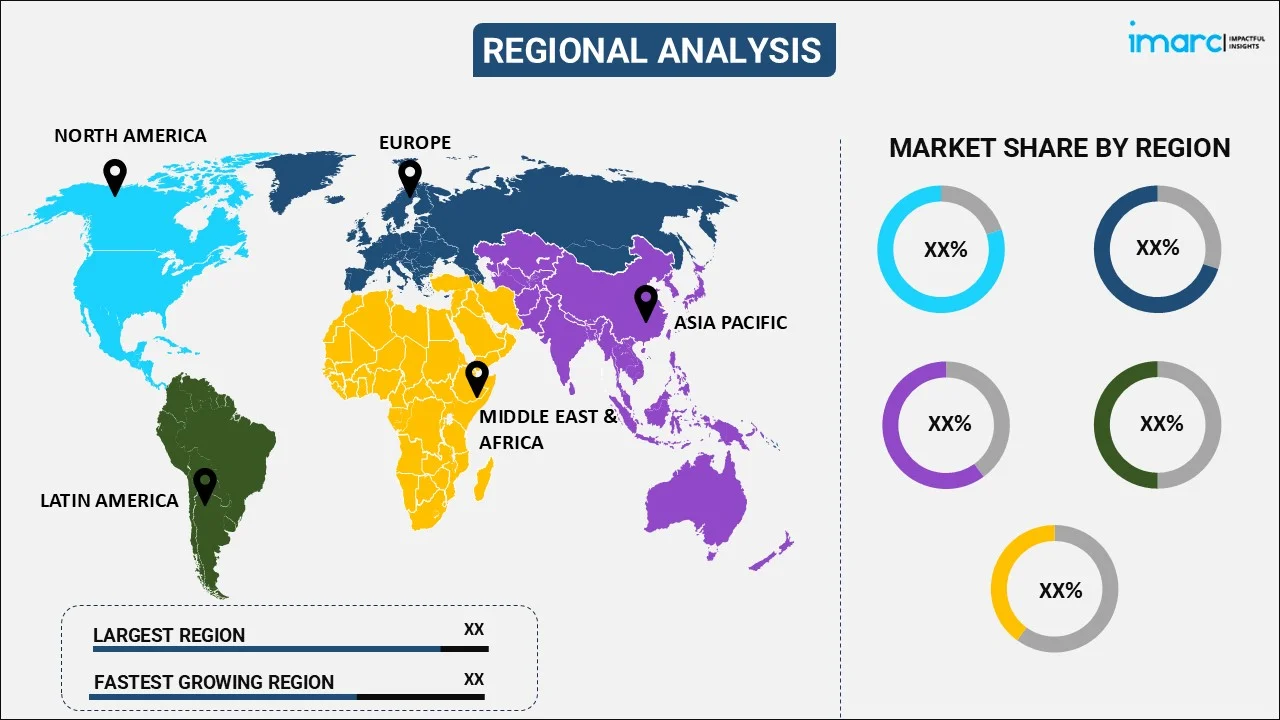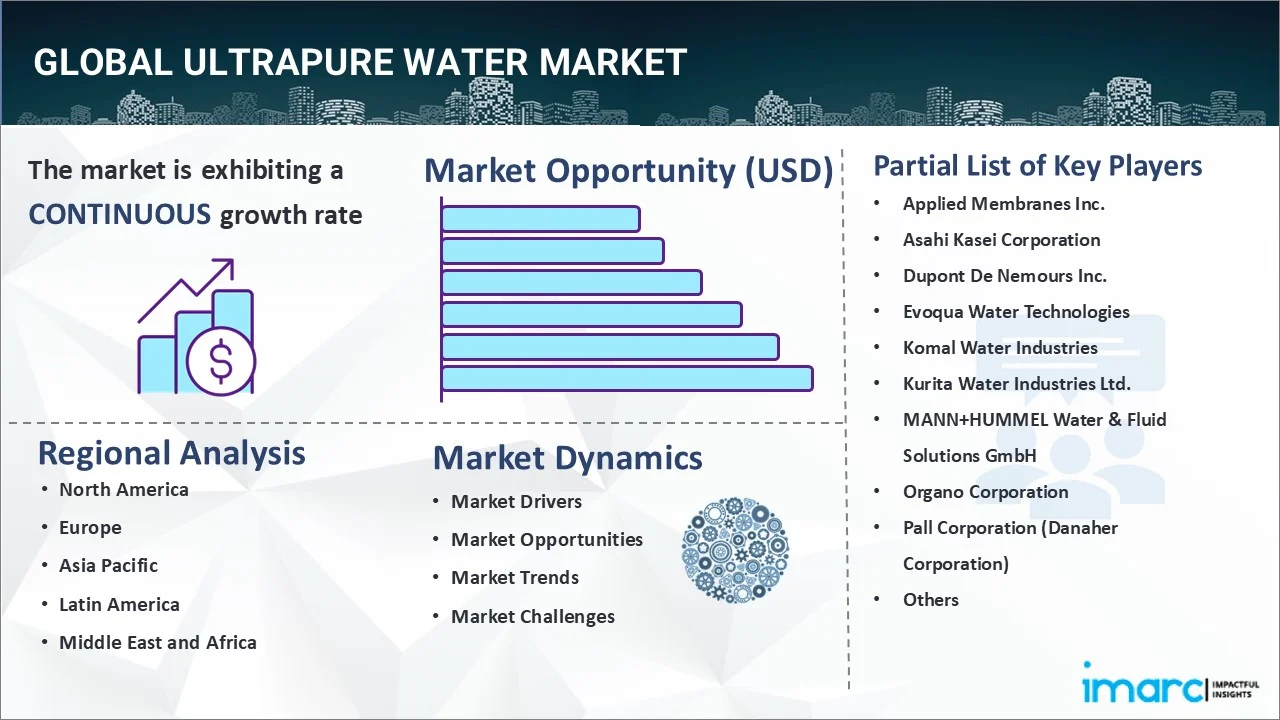
Ultrapure Water Market Report by Materials and Services (Filtration, Consumables/Aftermarket, and Others), Application (Washing Fluid, Process Feed), End Use Industry (Semiconductor, Pharmaceuticals, Power Generation, and Others), and Region 2025-2033
Ultrapure Water Market Overview:
The global ultrapure water market size reached USD 9.5 Billion in 2024. Looking forward, IMARC Group expects the market to reach USD 17.7 Billion by 2033, exhibiting a growth rate (CAGR) of 6.82% during 2025-2033. The strict purity standards in semiconductor, pharmaceutical, and power industries, regulatory focus on water quality, technological advancements in purification techniques, and the expansion of high-tech manufacturing represent some of the key factors driving the market growth.
|
Report Attribute
|
Key Statistics
|
|---|---|
|
Base Year
|
2024
|
|
Forecast Years
|
2025-2033
|
|
Historical Years
|
2019-2024
|
|
Market Size in 2024
|
USD 9.5 Billion |
|
Market Forecast in 2033
|
USD 17.7 Billion |
| Market Growth Rate (2025-2033) | 6.82% |
Ultrapure Water Market Analysis:
- Major Market Drivers: The ultrapure water market is primarily driven by the stringent requirements of industries, such as semiconductors, pharmaceuticals, and power generation, which demand exceptionally pure water. In addition, the global rise in the rules and regulations on water quality and environmental standards has encouraged industries to adopt ultrapure water systems, thereby favoring the market growth. Moreover, the advent of novel water treatment technologies in the field of ultrapure water production increase the efficiency and effectiveness of the production, thus surging their demand in different sectors that use high-purity water for critical processes.
- Key Market Trends: The ultrapure water industry is increasingly adopting digital technologies and automation in water purification systems. The IoT-enabled devices and data analytics are utilized to monitor water quality and system performance in real time, which, in turn, enhances operational efficiency. There is also a growing focus on sustainability, leading to innovations in water recycling and waste reduction within ultrapure water systems. The growth of the electronics manufacturing sector, especially in the Asia Pacific regions, is boosting the demand for ultrapure water, leading to market expansion and increased investment in high-tech industries.
- Geographic Trends: Asia Pacific dominates the ultrapure water market due to its rapidly expanding electronics manufacturing sector, stringent environmental regulations, and significant investments in semiconductor and pharmaceutical industries. The region's focus on technological advancements and infrastructure development further boosts its leadership in the global ultrapure water market.
- Competitive Landscape: Some of the major market players in the downhole tools industry include Applied Membranes Inc., Asahi Kasei Corporation, Dupont De Nemours Inc., Evoqua Water Technologies, Komal Water Industries, Kurita Water Industries Ltd., MANN+HUMMEL Water & Fluid Solutions GmbH, Organo Corporation, Pall Corporation (Danaher Corporation), Pentair plc and RODI Systems Corporation, among many others.
- Challenges and Opportunities: One of the main difficulties in the ultrapure water market is to deal with the operation and maintenance costs of the ultrapure water systems. The pursuit of the constant updating of technologies to comply with the changing industry standards is also a problem. On the other hand, these problems are also the sources of the expansion of the market through the development of the new technologies with the low cost and the systems that use less energy. Furthermore, the growth of the industrial sectors that demand ultrapure water in the emerging markets offers the development of the global and regional markets a great chance. The increasing trend of going green and the progress towards the reduction of the environmental impact of industrial processes opens new opportunities for the development of the ultrapure water technology.
Ultrapure Water Market Trends:
Advancements In Ultrapure Water Systems
Technological Innovation is one of the major trends that are taking the lead in the pure ultra water market. Ultrapure water systems are extensively utilized in the manufacturing and the semiconductor industry due to their advanced features and capabilities. Chemical impurities are eliminated from water in the ultra-pure water systems primarily through de-ionization (DI) and reverse osmosis. Lately, there has been an increasing demand EDI ultra-pure water systems, which uses electricity, ion exchange membranes, and resin to remove ionized species from water, thereby producing ultra-pure water. Most of the leading companies in the ultra-pure water industry are concentrating on the technological developments to keep up their market share. For instance, in January 2021, Merck and Co., a US-based pharmaceutical company, launched Milli-Q EQ 7000 ultra-pure Water Purification System. The new Milli-Q EQ 7000 system generates consistent ultrapure water quality that is flexibly tailored to experimental needs. This sophisticated system provides a comprehensive qualification procedure, advanced data traceability, and precise TOC monitoring.
Innovative Centralized Systems
Major companies in the ultrapure water market are developing centralized laboratory water purification systems that can cater to diverse laboratory needs. These systems are designed to integrate seamlessly with other water treatment technologies, enhancing their versatility and applicability. A centralized laboratory water purification system is a cost-saving and efficient solution to the high-quality, laboratory-grade water (Types I, II, and III) that can be used for multiple laboratory applications in a building. For instance, in January 2023, Envirogen Group, a UK-based industrial engineering company, launched LabPure, which is a centralized, energy-efficient ultra-pure water purification system designed for lab environments requiring ultra-pure water Type 1. It uses chemical-free RO-EDI technology and offers 150 to 1000 l/h flow rates for various applications. It meets regulatory and design compliance standards and can be adjusted to meet specific requirements, optimizing energy savings and space efficiency.
Demand for Ultrapure Water by Semiconductor Manufacturing Industry
The ultrapure water is in high demand in the semiconductor manufacturing industry, and this is the main cause of the increasing usage in the market. The semiconductor manufacturing industry is the one that involves companies in the production of semiconductors, where electronic devices are made by a sequence of nanofabrication procedures that are carried out on the surface of the substrates that are pure single crystal silicon. In every semiconductor industry, the manufacturing process is to be executed with the use of ultrapure water at every stage. Processes and water treatment technologies are necessary for the treatment of intake waters to the high levels of quality to the elimination of pollutants, minerals, microbes and trace organic and nonorganic compounds. For instance, in March 2022, according to the annual report published by TSMC, a Taiwan-based semiconductor manufacturing company, \the company recorded an increase in water usage from 77,257,163 m3 in 2020 to 82,674,982 m3 in 2021.
Ultrapure Water Market Segmentation:
IMARC Group provides an analysis of the key trends in each sub-segment of the global ultrapure water market report, along with forecasts at the global, regional, and country level from 2025-2033. Our report has categorized the market based on materials and services, application, and end use industry.
Breakup by Materials and Services:

- Filtration
- Consumables/Aftermarket
- Others
Filtration accounts for the largest market share
The report has provided a detailed breakup and analysis of the market based on the materials and services. This includes filtration, consumables/aftermarket, and others. According to the report, filtration represented the largest segment.
Filtration is a vital part in the production of ultrapure water, which is necessary for the processes of different high-tech manufacturing. In the realm of ultrapure water, filtration systems are the key to the removal of contaminants that can reach the sub-micron level; applying to systems such as microfiltration, ultrafiltration, reverse osmosis, and ion exchange. These technologies are crucial for achieving the high purity levels required, particularly in industries where even minute impurities can significantly affect product quality. The continuous advancements and enhancements in filtration technology have led to increased efficiency and reliability, thus, this section becomes the main force behind the ultrapure water market.
Breakup by Application:
- Washing Fluid
- Process Feed
Washing Fluid accounts for the largest market share
The report has provided a detailed breakup and analysis of the market based on the application. This includes washing fluid and process feed. According to the report, washing fluid represented the largest segment.
In the case of applications like washing fluids, ultrapure water is the absolute necessary for the no residues or contaminants to come in contact with the substrates or the products being cleaned. The fact that this is extremely important in high-precision industries where the purity of cleaning fluids directly affects the quality and performance of the final products is worth mentioning. Ultrapure water, that is used as a washing fluid, aids in the perfect cleaning that meets the high standards of regulatory and quality and thus, it creates the demand of this washing in specialized washing applications.
Breakup by End Use Industry:
- Semiconductor
- Pharmaceuticals
- Power Generation
- Others
Semiconductor accounts for the largest market share
The report has provided a detailed breakup and analysis of the market based on the end use industry. This includes semiconductor, pharmaceuticals, power generation, and others. According to the report, semiconductor represented the largest segment.
The semiconductor industry is among the biggest usage of ultrapure water as it is used in semiconductor wafer fabrication processes. Each phase of the semiconductor production process, including rinsing cleaning, and etching, needs the ultrapure water to prevent the contamination, which can result in the defects in semiconductor chips.
As the semiconductor industry continues to grow and evolve, characterized by trends towards smaller chip sizes and more complex structures, the demand for ultrapure water with even higher purity levels will increase. This heightened demand is expected to significantly boost market growth in this segment.
Breakup by Region:

- North America
- United States
- Canada
- Asia-Pacific
- China
- Japan
- India
- South Korea
- Australia
- Indonesia
- Others
- Europe
- Germany
- France
- United Kingdom
- Italy
- Spain
- Russia
- Others
- Latin America
- Brazil
- Mexico
- Others
- Middle East and Africa
Asia Pacific dominates the market
The report has provided a detailed breakup and analysis of the market based on the region. This includes North America (United States, Canada); Asia-Pacific (China, Japan, India, South Korea, Australia, Indonesia, Others); Europe (Germany, France, United Kingdom, Italy, Spain, Russia, Others); Latin America (Brazil, Mexico, Others), and Middle East and Africa. According to the report, Asia Pacific represented the largest segment.
The Asia Pacific region is the foremost market for the global ultrapure water industry, mainly because of the fast development of the semiconductor manufacturing, pharmaceuticals, and power generation industries, in particular, in countries such as China and South Korea. These countries are mainly the locations of the major semiconductor manufacturing hubs that consume huge volumes of ultrapure water. The regional market is also supported by the government's investments in infrastructure and the policies which favour the technological advancements, thus, making it a powerful market factor. Also, the ever-growing attention on the high-purity standards in the pharmaceuticals and the power generation sector's increase, are the reasons for the strong demand for ultrapure water in Asia Pacific.
Competitive Landscape:
- The market research report has also provided a comprehensive analysis of the competitive landscape in the market. Detailed profiles of all major companies have been provided. Some of the major market players in the ultrapure water market include Applied Membranes Inc., Asahi Kasei Corporation, Dupont De Nemours Inc., Evoqua Water Technologies, Komal Water Industries, Kurita Water Industries Ltd., MANN+HUMMEL Water & Fluid Solutions GmbH, Organo Corporation, Pall Corporation (Danaher Corporation) and Pentair plc and RODI Systems Corporation.
(Please note that this is only a partial list of the key players, and the complete list is provided in the report.)
- The major companies in the ultrapure water market use different ways to improve their market position and satisfy the rising need for ultrapure water across different industries. The strategies employed include technological innovations aimed at developing more efficient and cost-effective water purification systems. Mergers and acquisitions are prevalent, enabling companies to enter markets where they can achieve full development and integration. Strategic partnerships with industries heavily dependent on ultrapure water, such as semiconductors and pharmaceuticals, are also common. Additionally, corporations invest significantly in research and development to generate new ideas in filtration efficiency and sustainability, thereby reducing the environmental impact of their purification processes.
Ultrapure Water Market News:
- In May 2024, the Japanese technology company Asahi Kasei is accelerating its hydrogen business activities. Company representatives and partners, including the Japanese government, celebrated the official opening of a new hydrogen pilot plant in Kawasaki, Japan. Operation start of this commercial-scale facility was in March 2024. The trial operation of four 0.8 MW modules is another milestone towards the realization of a commercial multi-module 100 MW-class alkaline water electrolysis system for green hydrogen production.
- In February 2023, Evoqua Water Technologies, an industry leader in mission-critical water treatment solutions, announced that it has entered into a definitive agreement to divest its carbon reactivation and slurry operations to DESOTEC, the European market leader for industrial mobile filtration solutions based on activated carbon technology.
Ultrapure Water Market Report Scope:
| Report Features | Details |
|---|---|
| Base Year of the Analysis | 2024 |
| Historical Period | 2019-2024 |
| Forecast Period | 2025-2033 |
| Units | Billion USD |
| Scope of the Report | Exploration of Historical and Forecast Trends, Industry Catalysts and Challenges, Segment-Wise Historical and Predictive Market Assessment:
|
| Materials and Services Covered | Filtration, Consumables/Aftermarket, Others |
| Applications Covered | Washing Fluid, Process Feed |
| End Use Industries Covered | Semiconductor, Pharmaceuticals, Power Generation, Others |
| Regions Covered | Asia Pacific, Europe, North America, Latin America, Middle East and Africa |
| Countries Covered | United States, Canada, Germany, France, United Kingdom, Italy, Spain, Russia, China, Japan, India, South Korea, Australia, Indonesia, Brazil, Mexico |
| Companies Covered | Applied Membranes Inc., Asahi Kasei Corporation, Dupont De Nemours Inc., Evoqua Water Technologies, Komal Water Industries, Kurita Water Industries Ltd., MANN+HUMMEL Water & Fluid Solutions GmbH, Organo Corporation, Pall Corporation (Danaher Corporation), Pentair plc and RODI Systems Corporation |
| Customization Scope | 10% Free Customization |
| Post-Sale Analyst Support | 10-12 Weeks |
| Delivery Format | PDF and Excel through Email (We can also provide the editable version of the report in PPT/Word format on special request) |
Key Benefits for Stakeholders:
- IMARC’s industry report offers a comprehensive quantitative analysis of various market segments, historical and current market trends, market forecasts, and dynamics of the ultrapure water market from 2019-2033.
- The research report provides the latest information on the market drivers, challenges, and opportunities in the ultrapure water market.
- The study maps the leading, as well as the fastest-growing, regional markets. It further enables stakeholders to identify the key country-level markets within each region.
- Porter's five forces analysis assists stakeholders in assessing the impact of new entrants, competitive rivalry, supplier power, buyer power, and the threat of substitution. It helps stakeholders to analyze the level of competition within the ultrapure water industry and its attractiveness.
- The competitive landscape allows stakeholders to understand their competitive environment and provides an insight into the current positions of key players in the market.
Key Questions Answered in This Report
The ultrapure water market was valued at USD 9.5 Billion in 2024.
We expect the global ultrapure water market to exhibit a CAGR of 6.82% during 2025-2033.
The rising demand for ultrapure water to clean small and minute electronic equipment, including semiconductors and wafers, is primarily driving the global ultrapure water market.
The sudden outbreak of the COVID-19 pandemic had led to the implementation of stringent lockdown regulations across several nations resulting in the temporary closure of numerous end-use industries for ultrapure water.
Based on the materials and services, the global ultrapure water market can be segmented into filtration, consumables/aftermarket, and others. Currently, filtration holds the majority of the total market share.
Based on the application, the global ultrapure water market has been divided into washing fluid and process feed, where washing fluid currently exhibits a clear dominance in the market.
Based on the end use industry, the global ultrapure water market can be categorized into semiconductor, pharmaceuticals, power generation, and others. Currently, semiconductor accounts for the largest market share.
On a regional level, the market has been classified into North America, Asia-Pacific, Europe, Latin America, and Middle East and Africa, where Asia-Pacific currently dominates the global market.
Some of the major players in the global ultrapure water market include Applied Membranes Inc., Asahi Kasei Corporation, Dupont De Nemours Inc., Evoqua Water Technologies, Komal Water Industries, Kurita Water Industries Ltd., MANN+HUMMEL Water & Fluid Solutions GmbH, Organo Corporation, Pall Corporation (Danaher Corporation), Pentair plc, and RODI Systems Corporation.
Need more help?
- Speak to our experienced analysts for insights on the current market scenarios.
- Include additional segments and countries to customize the report as per your requirement.
- Gain an unparalleled competitive advantage in your domain by understanding how to utilize the report and positively impacting your operations and revenue.
- For further assistance, please connect with our analysts.

 Inquire Before Buying
Inquire Before Buying
 Speak to an Analyst
Speak to an Analyst
 Request Brochure
Request Brochure
 Request Customization
Request Customization




.webp)




.webp)












